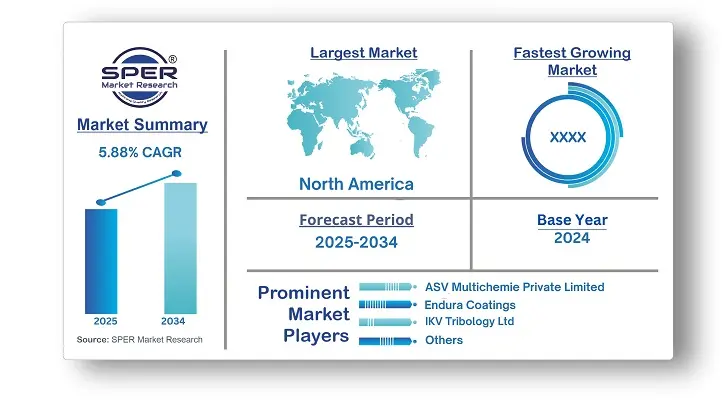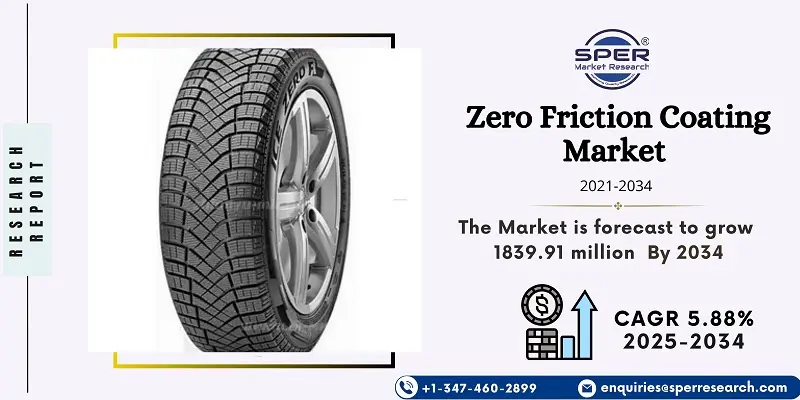Zero Friction Coating Market and Overview
According to SPER Market Research, the Global Zero Friction Coating Market is estimated to reach USD 1839.91 million by 2034 with a CAGR of 5.88%.
The report includes an in-depth analysis of the Global Zero Friction Coating Market, including market size and trends, product mix, Applications, and supplier analysis. The increasing demand for zero friction coatings is driven by their ability to provide both lubrication and corrosion protection, thereby extending the lifespan of components used in industries like automotive, energy, and aerospace. These coatings allow surfaces to interact with minimal wear, reducing component degradation. Essential features like resistance to vacuum and radiation, clean and dry lubrication that remains effective even in dusty environments, non-flammability, and strong oxidation resistance are anticipated to further drive market growth in the coming years. However, challenges such as high friction under low loads and an elevated coefficient of friction in humid conditions may hinder market expansion.
By Type:
The molybdenum disulfide (MoS₂) segment emerged as the dominant type, owing to its excellent load-bearing capacity and strong adhesion properties. As a dry film lubricant, MoS₂ effectively prevents galling, fretting, and seizing, while performing reliably in a wide temperature range from -350°F to +500°F. It also offers a low coefficient of friction (0.07) and resists reaction with most corrosive agents, making it suitable for critical parts. The polytetrafluoroethylene (PTFE) segment ranked second and is expected to grow steadily in the coming years.
By Formulation:
The solvent-based segment led the market in 2021, primarily due to its reduced sensitivity to environmental factors such as humidity and temperature during the curing process. The water-based coating segment followed closely, showing strong growth potential driven by its low volatile organic compound (VOC) content, durability under accelerated aging conditions, and its ability to incorporate pigments. Additionally, water-based coatings offer lower friction and improved resistance to weathering, further contributing to their increasing adoption.
By Formulation:
The automobile and transportation segment held the leading position in the market. This dominance is largely due to the ability of zero friction coatings to reduce noise, making them well-suited for automotive applications—particularly in minimizing cabin noise, which has become a key focus in modern vehicles. The expanding global automotive market, along with the increasing adoption of electric vehicles, is expected to further support the growth of the industry, thereby positively influencing the demand for zero friction coatings.
By Regional Insights
Asia Pacific emerged as the leading region in the zero friction coatings market, largely due to the strong presence of automotive manufacturing hubs in countries like Japan, South Korea, and China. The region benefits from being home to several major automotive brands, including Honda, Toyota, Ford, and BMW. Additionally, Southeast Asia is recognized as a significant player in global vehicle production, further boosting regional demand. The continuous expansion of the automobile industry in Asia Pacific is expected to drive the adoption of zero friction coatings in the coming years. Europe also played a notable role in the market and is projected to experience steady growth, supported by an increase in vehicle production despite challenges related to supply chain disruptions.
Market Competitive Landscape
The market is moderately consolidated. Some of the market key players are, GMM Coatings Private Limited, IKV Tribology Ltd., Poeton, VITRACOAT, ASV Multichemie Private Limited, Bechem, DuPont, Endura Coatings.
Recent Developments:
In 2022, PPG announced the completion of its acquisition of the powder coatings manufacturing division of Arsonsisi, an industrial coatings firm headquartered in Milan, Italy. This acquisition adds a highly automated powder manufacturing facility in Verbania, Italy, to PPG’s portfolio, capable of handling both small and large batch production.
Scope of the report:
| Report Metric | Details |
| Market size available for years | 2021-2034 |
| Base year considered | 2024 |
| Forecast period | 2025-2034 |
| Segments covered | By Type, By Formulation, By End Use |
| Regions covered | North America, Latin America, Asia-Pacific, Europe, and Middle East & Africa |
| Companies Covered | ASV Multichemie Private Limited, Bechem, DuPont, Endura Coatings, GMM Coatings Private Limited, IKV Tribology Ltd., Poeton, VITRACOAT.
|
Key Topics Covered in the Report
Global Zero Friction Coating Market Size (FY’2021-FY’2034)
Overview of Global Zero Friction Coating Market
Segmentation of Global Zero Friction Coating Market By Type (Polytetrafluoroethylene, Molybdenum Disulfide, Others)
Segmentation of Global Zero Friction Coating Market By Formulation (Solvent-based Coatings, Water-based Coatings, Powder Coatings)
Segmentation of Global Zero Friction Coating Market By End-use (Automobile & Transportation, Aerospace, General Engineering, Food & Healthcare, Energy, Others)
Statistical Snap of Global Zero Friction Coating Market
Expansion Analysis of Global Zero Friction Coating Market
Problems and Obstacles in Global Zero Friction Coating Market
Competitive Landscape in the Global Zero Friction Coating Market
Details on Current Investment in Global Zero Friction Coating Market
Competitive Analysis of Global Zero Friction Coating Market
Prominent Players in the Global Zero Friction Coating Market
SWOT Analysis of Global Zero Friction Coating Market
Global Zero Friction Coating Market Future Outlook and Projections (FY’2025-FY’2034)
Recommendations from Analyst
1. Introduction
1.1. Scope of the report
1.2. Market segment analysis
2. Research Methodology
2.1. Research data source
2.1.1. Secondary Data
2.1.2. Primary Data
2.1.3. SPER’s internal database
2.1.4. Premium insight from KOL’s
2.2. Market size estimation
2.2.1. Top-down and Bottom-up approach
2.3. Data triangulation
3. Executive Summary
4. Market Dynamics
4.1. Driver, Restraint, Opportunity and Challenges analysis
4.1.1. Drivers
4.1.2. Restraints
4.1.3. Opportunities
4.1.4. Challenges
5. Market variable and outlook
5.1. SWOT Analysis
5.1.1. Strengths
5.1.2. Weaknesses
5.1.3. Opportunities
5.1.4. Threats
5.2. PESTEL Analysis
5.2.1. Political Landscape
5.2.2. Economic Landscape
5.2.3. Social Landscape
5.2.4. Technological Landscape
5.2.5. Environmental Landscape
5.2.6. Legal Landscape
5.3. PORTER’s Five Forces
5.3.1. Bargaining power of suppliers
5.3.2. Bargaining power of buyers
5.3.3. Threat of Substitute
5.3.4. Threat of new entrant
5.3.5. Competitive rivalry
5.4. Heat Map Analysis
6. Competitive Landscape
6.1. Global Zero Friction Coating Market Manufacturing Base Distribution, Sales Area, Product Type
6.2. Mergers & Acquisitions, Partnerships, Product Launch, and Collaboration in Global Zero Friction Coating Market
7. Global Zero Friction Coating Market, By Type, (USD Million) 2021-2034
7.1. Polytetrafluoroethylene
7.2. Molybdenum Disulfide
7.3. Others
8. Global Zero Friction Coating Market, By Formulation, (USD Million) 2021-2034
8.1. Solvent-based Coatings
8.2. Water-based Coatings
8.3. Powder Coatings
9. Global Zero Friction Coating Market, By End-use, (USD Million) 2021-2034
9.1. Automobile & Transportation
9.2. Aerospace
9.3. General Engineering
9.4. Food & Healthcare
9.5. Energy
9.6. Others
10. Global Zero Friction Coating Market, (USD Million) 2021-2034
10.1. Global Zero Friction Coating Market Size and Market Share
11. Global Zero Friction Coating Market, By Region, 2021-2034 (USD Million)
11.1. Asia-Pacific
11.1.1. Australia
11.1.2. China
11.1.3. India
11.1.4. Japan
11.1.5. South Korea
11.1.6. Rest of Asia-Pacific
11.2. Europe
11.2.1. France
11.2.2. Germany
11.2.3. Italy
11.2.4. Spain
11.2.5. United Kingdom
11.2.6. Rest of Europe
11.3. Middle East and Africa
11.3.1. Kingdom of Saudi Arabia
11.3.2. United Arab Emirates
11.3.3. Qatar
11.3.4. South Africa
11.3.5. Egypt
11.3.6. Morocco
11.3.7. Nigeria
11.3.8. Rest of Middle-East and Africa
11.4. North America
11.4.1. Canada
11.4.2. Mexico
11.4.3. United States
11.5. Latin America
11.5.1. Argentina
11.5.2. Brazil
11.5.3. Rest of Latin America
12. Company Profile
12.1. ASV Multichemie Private Limited
12.1.1. Company details
12.1.2. Financial outlook
12.1.3. Product summary
12.1.4. Recent developments
12.2. Bechem
12.2.1. Company details
12.2.2. Financial outlook
12.2.3. Product summary
12.2.4. Recent developments
12.3. DuPont
12.3.1. Company details
12.3.2. Financial outlook
12.3.3. Product summary
12.3.4. Recent developments
12.4. Endura Coatings
12.4.1. Company details
12.4.2. Financial outlook
12.4.3. Product summary
12.4.4. Recent developments
12.5. GMM Coatings Private Limited
12.5.1. Company details
12.5.2. Financial outlook
12.5.3. Product summary
12.5.4. Recent developments
12.6. IKV Tribology Ltd.
12.6.1. Company details
12.6.2. Financial outlook
12.6.3. Product summary
12.6.4. Recent developments
12.7. Poeton
12.7.1. Company details
12.7.2. Financial outlook
12.7.3. Product summary
12.7.4. Recent developments
12.8. VITRACOAT
12.8.1. Company details
12.8.2. Financial outlook
12.8.3. Product summary
12.8.4. Recent developments
12.9. Others
13. Conclusion
14. List of Abbreviations
15. Reference Links
SPER Market Research’s methodology uses great emphasis on primary research to ensure that the market intelligence insights are up to date, reliable and accurate. Primary interviews are done with players involved in each phase of a supply chain to analyze the market forecasting. The secondary research method is used to help you fully understand how the future markets and the spending patterns look likes.
The report is based on in-depth qualitative and quantitative analysis of the Product Market. The quantitative analysis involves the application of various projection and sampling techniques. The qualitative analysis involves primary interviews, surveys, and vendor briefings. The data gathered as a result of these processes are validated through experts opinion. Our research methodology entails an ideal mixture of primary and secondary initiatives.





































